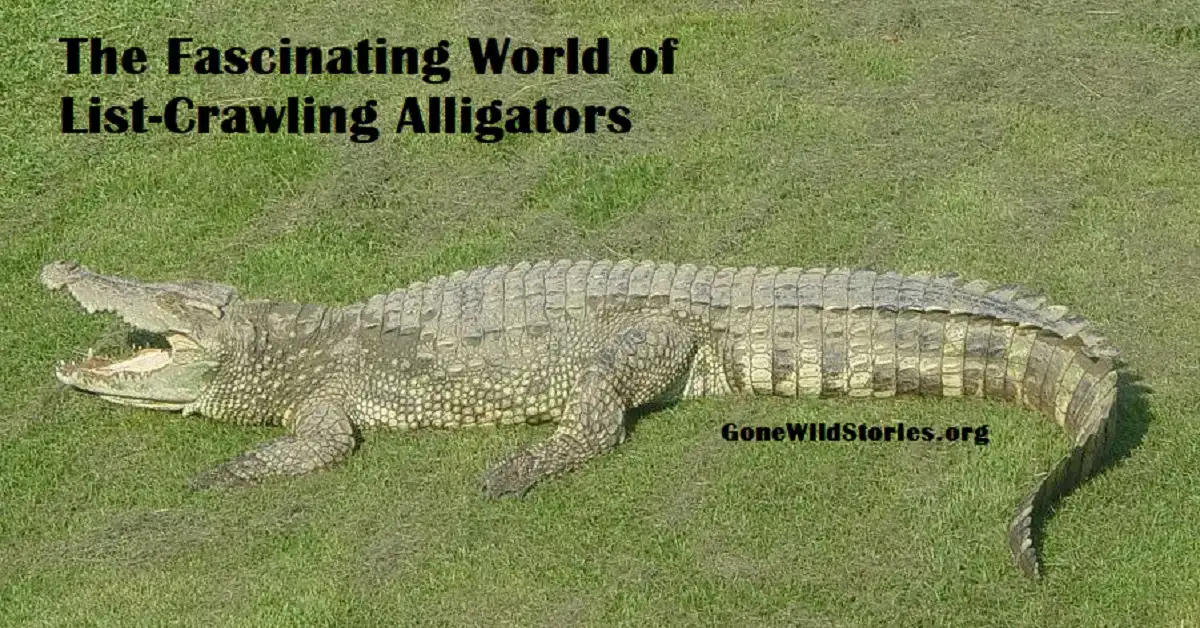Exploring the Depths: The Fascinating World of List-Crawling Alligators
Table of Contents
- Introduction
- Understanding Alligator Behavior
- The Mechanics of List Crawling
- Ecological Significance of List Crawling
- Research and Observations
- Conservation Implications
- Conclusion
- FAQs
Introduction
Alligators, the formidable apex predators of freshwater ecosystems, have captivated the interest of researchers and wildlife enthusiasts alike. Found primarily in the southeastern United States and parts of China, these reptiles are renowned for their powerful jaws and stealthy hunting techniques. Among their intriguing behaviors is “list crawling,” a unique movement pattern that allows alligators to navigate their environments with remarkable stealth. This article aims to explore the mechanics, ecological significance, and conservation implications of list crawling, shedding light on how this behavior contributes to the alligator’s survival and the health of its ecosystem.
| Aspect | Details |
|---|---|
| Subject | Alligators |
| Habitat | Primarily found in the southeastern United States and parts of China |
| Key Characteristics | Apex predators, powerful jaws, stealthy hunting techniques |
| Focus Behavior | List crawling |
| Definition of List Crawling | A unique movement pattern that allows alligators to navigate stealthily and approach prey without detection |
| Purpose of the Article | To explore the mechanics, ecological significance, and conservation implications of list crawling in alligators |
Understanding Alligator Behavior
General Behavior of Alligators in the Wild
Alligators are primarily solitary creatures, although they may gather in groups during mating season or in areas with abundant food. They are opportunistic feeders, preying on fish, birds, small mammals, and even other reptiles. Their hunting strategy often involves lying in wait, camouflaged in the water, before launching a sudden attack. Alligators are also territorial, using vocalizations and physical displays to assert dominance over their space.
Introduction to List Crawling Behavior
List crawling is a specific movement pattern observed in alligators, characterized by a slow, deliberate crawl along the ground or submerged in shallow water. This behavior is often seen when alligators are navigating through dense vegetation or when they are attempting to approach prey without being detected. Understanding this behavior provides insight into the adaptability and survival strategies of alligators in their natural habitats.
The Mechanics of List Crawling
Description of the Physical Movements Involved
List crawling involves a unique combination of movements that allow alligators to maneuver stealthily. The alligator uses its powerful limbs to push against the ground while keeping its body low to the surface. This minimizes noise and reduces the likelihood of detection by both prey and potential threats. The alligator’s tail also plays a crucial role in maintaining balance and propulsion during this movement.
Situations That Trigger List Crawling
Several factors can trigger list crawling behavior in alligators:
-
Environmental Factors: Changes in water levels can force alligators to navigate through marshy areas or dense vegetation, prompting the use of list crawling to avoid detection.
-
Behavioral Triggers: During mating season, male alligators may engage in list crawling to approach females or to assert dominance over rival males. Additionally, when hunting, alligators may employ this technique to sneak up on unsuspecting prey.
Ecological Significance of List Crawling
Role in the Alligator’s Ecosystem
List crawling plays a vital role in the alligator’s ecological niche. By allowing them to approach prey stealthily, this behavior enhances their hunting success, which in turn helps regulate prey populations. Alligators are considered keystone species, meaning their presence and behavior significantly impact the structure of their ecosystem.
Interactions with Other Species
Alligators’ list crawling behavior also influences their interactions with other species. As predators, they help control populations of fish and small mammals, which can prevent overgrazing of aquatic vegetation. Additionally, their nesting activities create habitats for other species, contributing to biodiversity in their ecosystems.
Research and Observations
Overview of Studies on Alligator Behavior
Research on alligator behavior, including list crawling, has been conducted by various wildlife biologists and ecologists. Studies often involve direct observation in the field, tracking alligator movements, and analyzing their hunting strategies. Key findings suggest that list crawling is not only a survival tactic but also a learned behavior that can vary among individuals based on their experiences and environmental conditions.
Anecdotal Evidence and Observations from Wildlife Experts
Wildlife experts have noted that list crawling is particularly prevalent in younger alligators, who may rely on stealth more than larger, more dominant individuals. Observations in the field have shown that alligators can adapt their crawling techniques based on the terrain, demonstrating their intelligence and adaptability.
Conservation Implications
Importance of Understanding Alligator Behavior for Conservation Efforts
Understanding alligator behavior, including list crawling, is crucial for effective conservation strategies. As apex predators, alligators play a significant role in maintaining the health of their ecosystems. Protecting their habitats ensures the survival of not only alligators but also the myriad species that depend on these environments.
Threats to Alligator Habitats and Behaviors
Alligator populations face numerous threats, including habitat loss due to urban development, pollution, and climate change. These factors can disrupt their natural behaviors, including list crawling, which may affect their hunting success and overall survival. Conservation efforts must focus on habitat preservation and restoration to ensure the continued existence of these remarkable reptiles.
Conclusion
In summary, list crawling is a fascinating behavior that underscores the adaptability and survival strategies of alligators in their natural habitats. By allowing these reptiles to approach prey stealthily, list crawling enhances their hunting success and plays a crucial role in maintaining the balance of their ecosystems. Understanding this behavior is vital for effective conservation efforts, especially in the face of habitat loss and climate change. Protecting alligator habitats not only ensures the survival of these remarkable creatures but also supports the diverse array of species that depend on healthy freshwater ecosystems. As we continue to study and appreciate the complexities of alligator behavior, we can better advocate for their conservation and the preservation of their environments.
FAQs
Q: What is list crawling in alligators?
A: A stealthy movement pattern allowing alligators to approach prey quietly.
Q: Why do alligators engage in list crawling?
A: To enhance their hunting success by sneaking up on prey.
Q: Are alligators the only reptiles that exhibit list crawling?
A: No, but the term is most commonly associated with alligators.
Q: How does list crawling impact the alligator’s ecosystem?
A: It helps regulate prey populations and maintains ecological balance.
Q: What threats do alligators face that could affect their behavior?
A: Habitat loss, pollution, and climate change disrupt their natural behaviors.
Q: How can we help conserve alligator habitats?
A: By supporting habitat preservation and educating the public on their importance.


